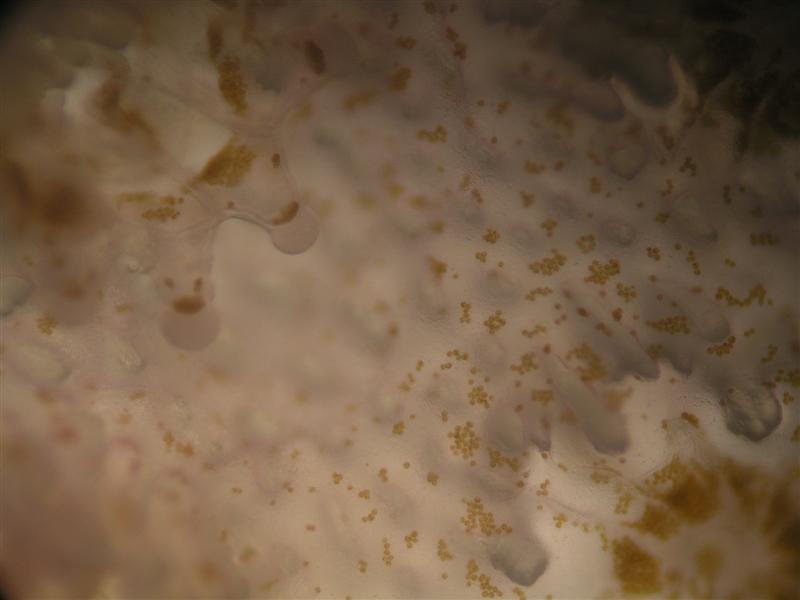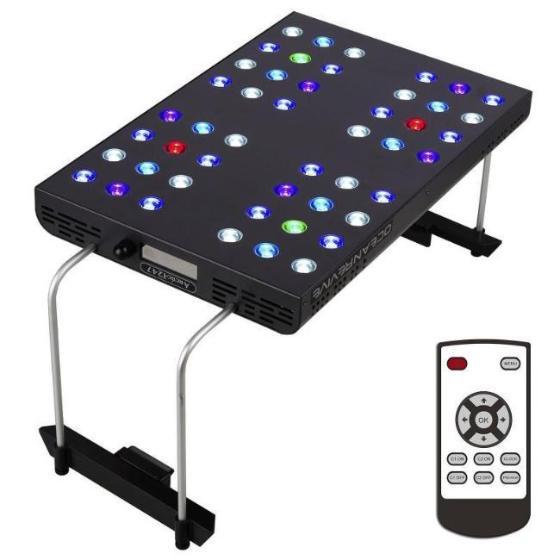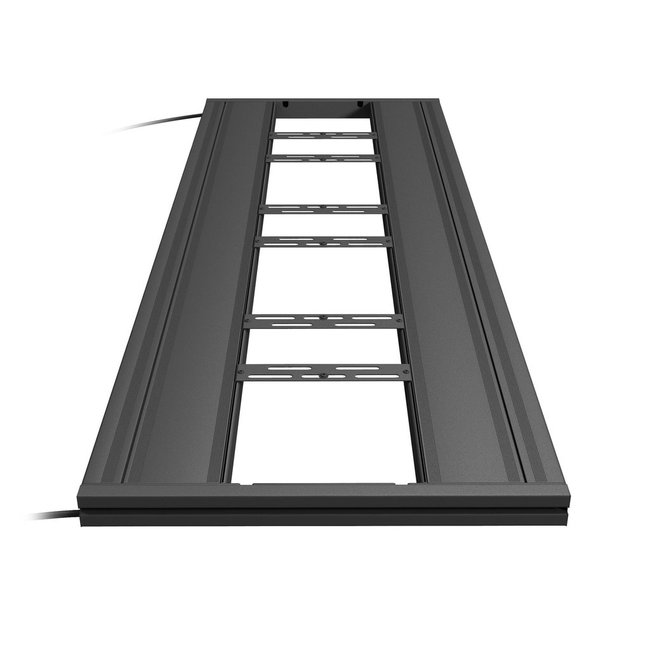"Successful" is always subjective, but to me it is stability, no losses, good growth and coloration. And I realize much of what I just wrote is subjective as well. Also, my goals/expectations are not the same for my display tank vs. my frag setup.How to define " a succesful reef tank"? In the 90's? In 2020?
A mixed reef tank or an SPC only tank? Is it about fluo colours, growth rates or density , survival rates after 6 months, a year, a decade? About VLNS, LNS or HIHOS?
We do know a lot more about symbiodinium and the coral holobiont, info wich was not available in the 90's. Now we do have other reasons for doing things as we had in the 90's. We do have reasons for doing it differently. Things happen for the same reasons, we do know a lot more about why things happen. Light is still the same, how it is used and produced has changed drastic.
How to define "succesfull reefing" only taking into account light quality, spectrum, intensity, photo-period?
Starting with light intensity and dept adapted corals ( above 3m) or low light intensity adapted corals ( below 20m) or starting with capture raised corals in for growth rates optimized conditions.? What are these conditions? High growth rate = lower density.
How important are nutrient levels and nutrient availability in combination with light conditions for a "succesful reef tank"
Why in a well lit aquarium available nutrients are not always used up by photoautotrophs having the availability of a theoretic unlimited energy source? In what way this effects "succesful reefkeeping"?
Navigation
Install the app
How to install the app on iOS
Follow along with the video below to see how to install our site as a web app on your home screen.
Note: This feature may not be available in some browsers.
More options
You are using an out of date browser. It may not display this or other websites correctly.
You should upgrade or use an alternative browser.
You should upgrade or use an alternative browser.
Light Intensity in Successful Reef Tanks
- Thread starter Dana Riddle
- Start date
- Tagged users None
I stated clearly that there is more to a successful tank than light alone, and also said that corals had to appear healthy showing good growth, coloration.How to define " a succesful reef tank"? In the 90's? In 2020?
A mixed reef tank or an SPC only tank? Is it about fluo colours, growth rates or density , survival rates after 6 months, a year, a decade? About VLNS, LNS or HIHOS?
We do know a lot more about symbiodinium and the coral holobiont, info wich was not available in the 90's. Now we do have other reasons for doing things as we had in the 90's. We do have reasons for doing it differently. Things happen for the same reasons, we do know a lot more about why things happen. Light is still the same, how it is used and produced has changed drastic.
How to define "succesfull reefing" only taking into account light quality, spectrum, intensity, photo-period?
Starting with light intensity and dept adapted corals ( above 3m) or low light intensity adapted corals ( below 20m) or starting with capture raised corals in for growth rates optimized conditions.? What are these conditions? High growth rate = lower density.
How important are nutrient levels and nutrient availability in combination with light conditions for a "succesful reef tank"
Why in a well lit aquarium available nutrients are not always used up by photoautotrophs having the availability of a theoretic unlimited energy source? In what way this effects "succesful reefkeeping"?
I'm surprised at the extremely wide range that yielded success. For instance A. formosa success at both 95 and 430...same species and variety if I'm reading it right. A. nana 75 up to 423.
Does this suggest that light intensity is not a huge factor? Maybe duration, spectrum and who knows what other non light related influences are far more important?
Does this suggest that light intensity is not a huge factor? Maybe duration, spectrum and who knows what other non light related influences are far more important?
Colours turned brown and green ... yes the brown and green look fine but the rest were not brown and green before.Colors look fine
Mate, I've been around this hobby long enough (30 years) to know how to acclimate corals to changes in light source. 5 Years after implementing LED the colours have not returned. I think that is long enough for the sps to acclimate to the change in light source.Don't be a *********, I don't follow you.
Maybe before making your prognosis, ask a question or 2, that would be more preferable.
There was a clue in my original post ... spectrum differences between MH and LED.
Last edited:
In some cases light intensity is critical. There are several hundred zooxanthellae clades, some are highly adaptable to light intensity (these are called generalists) while others thrive in only a narrow range of light. In general, Acropora species are tolerant of a broad range of light. I wrote several articles on the subject and can post links if anyone is interested.I'm surprised at the extremely wide range that yielded success. For instance A. formosa success at both 95 and 430...same species and variety if I'm reading it right. A. nana 75 up to 423.
Does this suggest that light intensity is not a huge factor? Maybe duration, spectrum and who knows what other non light related influences are far more important?
Yes, links please. I'm always willing to learn.
Yes, links please. I'm always willing to learn.

Getting Really Up to Date on Zooxanthellae (Symbiodinium spp.)
Why should anyone be interested in a rather obscure subject such as this? After all, we know that coral animals (hosts) and zooxanthellae (symbionts) generally have a mutually beneficial relationship. New information may make us re-think the symbiosis between Symbiodinium and coral animals.
I need to update this article. LaJeunesse published a paper with revisions, but WORMS hasn't recognized them yet.
Streetcred,I moved from 1800W of MH comprising 4x150/2x200/2x400W with a variety of lamp manufacturers (12000k - 18000k) to Inwatter then to GHL LEDs ... never achieved anything close to the sps coloration of the MH nor the UPAR intensities ... mostly turned brown or green ! Using a special spectrum program from a GHL reef specialist.
Beautiful reef to say the least. Love the sand slope, looks different and natural.
I'm a MH guy who's ventured in the led world but returned to mhs.
Do you mind sharing more details of the color change noticed?
I do not doubt LEDs can color sps just fine, am just curious as to your case what the experience was?
Do you believe newer led systems could be better options and maybe give you improved results? Im sure you spent a pretty penny with the GHLs you run now
I was interested by the coralline algae levels of growth to lower light.
Coralline and coral growth in my tank is good at 9 months now.
4c+4b+ 4" off the surface. High levels of light have given excecptional coralline growth.

Coralline and coral growth in my tank is good at 9 months now.
4c+4b+ 4" off the surface. High levels of light have given excecptional coralline growth.
Last edited:
Not trying to hijack your forum but I figured many of you could help with a lighting decision I'm facing. I'm currently cycling a 90g tank that I plan to move my 36 over to. At this point I've yet to purchase a light for this tank because of uncertainty and not wanting to buy something I may need to replace later down the road. So after tons of reading I've picked two different lights, however I'm struggling with choosing between the two. I need input on the choice, for now I only have softies but hope in time to have a wide range of corals except for the rare/extremely hard to grow. Currently only have $400 to spend but would like LED at some point either by hybrid option or full LED. Which would you choose?
1st choice - (2) Ocean Revive T247-B

 aquariumstoredepot.com
aquariumstoredepot.com
2nd choice - Aquaticlife G2 T5HO Hybrid LED, (As money allows add 2 AI Primes)

 www.saltwateraquarium.com
www.saltwateraquarium.com
1st choice - (2) Ocean Revive T247-B

Ocean Revive T247-B Full Spectrum Dimmable LED Reef Light
Stock Update - We are out of stock until Mid-May 2021. Please check with use again. Thank you for your patience! Ocean Revive T247-B - Quality Reef Worthy Lights That Won't Break the Bank!!! Quality
 aquariumstoredepot.com
aquariumstoredepot.com
2nd choice - Aquaticlife G2 T5HO Hybrid LED, (As money allows add 2 AI Primes)

48" G2 T5HO Hybrid LED T5 Mounting System BLACK w/End Caps - Aquatic Life
Shop The Best Saltwater Aquarium Equipment & Supplies at Saltwater Aquarium. We Carry Everything you will Need for your Fish Tank.
 www.saltwateraquarium.com
www.saltwateraquarium.com
- Joined
- May 21, 2018
- Messages
- 311
- Reaction score
- 307
I'd go with the t5s and later add the leds. T5s will be plenty of light for softies give even coverage and give the proper spectrum. Then later add the leds ai or if you want little more shimmer 2 kessil a160s would give you the blue pop and plenty of shimmer.Not trying to hijack your forum but I figured many of you could help with a lighting decision I'm facing. I'm currently cycling a 90g tank that I plan to move my 36 over to. At this point I've yet to purchase a light for this tank because of uncertainty and not wanting to buy something I may need to replace later down the road. So after tons of reading I've picked two different lights, however I'm struggling with choosing between the two. I need input on the choice, for now I only have softies but hope in time to have a wide range of corals except for the rare/extremely hard to grow. Currently only have $400 to spend but would like LED at some point either by hybrid option or full LED. Which would you choose?
1st choice - (2) Ocean Revive T247-B

Ocean Revive T247-B Full Spectrum Dimmable LED Reef Light
Stock Update - We are out of stock until Mid-May 2021. Please check with use again. Thank you for your patience! Ocean Revive T247-B - Quality Reef Worthy Lights That Won't Break the Bank!!! Qualityaquariumstoredepot.com
2nd choice - Aquaticlife G2 T5HO Hybrid LED, (As money allows add 2 AI Primes)

48" G2 T5HO Hybrid LED T5 Mounting System BLACK w/End Caps - Aquatic Life
Shop The Best Saltwater Aquarium Equipment & Supplies at Saltwater Aquarium. We Carry Everything you will Need for your Fish Tank.www.saltwateraquarium.com
Disregard I just read the article and posted the question before reading the discussionThis study was done in 1998-1999. Is there a recent study of modern lighting?
I've collected some data in tanks with LEDs. The issue is with ramping up and down and varying spectral data. In essence, when one is running such a schedule, we're dealing with a different light many times a day. Things were much more simple when we were dealing with an on/off cycle and a specific spectrum.This study was done in 1998-1999. Is there a recent study of modern lighting?
When dealing with programmable light sources (such as LEDs) I use a PAR meter to log intensity over the course of the photoperiod and calculate the Daily Light Integral (DLI.) Mine tank has a DLI of 13.
- Joined
- May 21, 2018
- Messages
- 311
- Reaction score
- 307
I'm thinking about getting an apex pmk if I do I might send you the results and have you help me out lol.I've collected some data in tanks with LEDs. The issue is with ramping up and down and varying spectral data. In essence, when one is running such a schedule, we're dealing with a different light many times a day. Things were much more simple when we were dealing with an on/off cycle and a specific spectrum.
When dealing with programmable light sources (such as LEDs) I use a PAR meter to log intensity over the course of the photoperiod and calculate the Daily Light Integral (DLI.) Mine tank has a DLI of 13.
I've collected some data in tanks with LEDs. The issue is with ramping up and down and varying spectral data. In essence, when one is running such a schedule, we're dealing with a different light many times a day. Things were much more simple when we were dealing with an on/off cycle and a specific spectrum.
When dealing with programmable light sources (such as LEDs) I use a PAR meter to log intensity over the course of the photoperiod and calculate the Daily Light Integral (DLI.) Mine tank has a DLI of 13.
This is something that I don't understand.............why people are running LEDs that way?.........it's in deterence to what the corals need.
It's much simpler to run them the same as traditonal lighting. One of the biggest mistakes these LED manufacturers made was to offer all these options and make the software so complex and unnecessary.
It's the same as giving a 20 handicap golfer the option to change weight and launch angles on a driver.
The only advantages I see with programmable LED luminaires are showcasing coral fluorescence and mimicking dawn/dusk that is apparently important in inducing spawnings in some fish species. But lights with programs for storms/lightning... give me a break.This is something that I don't understand.............why people are running LEDs that way?.........it's in deterence to what the corals need.
It's much simpler to run them the same as traditonal lighting. One of the biggest mistakes these LED manufacturers made was to offer all these options and make the software so complex and unnecessary.
It's the same as giving a 20 handicap golfer the option to change weight and launch angles on a driver.
Similar threads
- AMS: Article
- Replies
- 1
- Views
- 46
- Replies
- 2
- Views
- 85
- Replies
- 2
- Views
- 188
- Replies
- 4
- Views
- 137
- Replies
- 6
- Views
- 373














